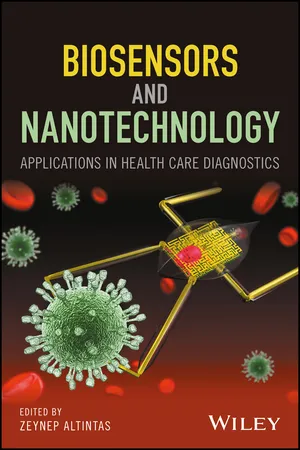
Biosensors and Nanotechnology
Applications in Health Care Diagnostics
Zeynep Altintas, Zeynep Altintas
- English
- ePUB (handyfreundlich)
- Über iOS und Android verfügbar
Biosensors and Nanotechnology
Applications in Health Care Diagnostics
Zeynep Altintas, Zeynep Altintas
Über dieses Buch
Provides a broad range of information from basic principles to advanced applications of biosensors and nanomaterials in health care diagnostics
This book utilizes a multidisciplinary approach to provide a wide range of information on biosensors and the impact of nanotechnology on the development of biosensors for health care. It offers a solid background on biosensors, recognition receptors, biomarkers, and disease diagnostics. An overview of biosensor-based health care applications is addressed. Nanomaterial applications in biosensors and diagnostics are included, covering the application of nanoparticles, magnetic nanomaterials, quantum dots, carbon nanotubes, graphene, and molecularly imprinted nanostructures. The topic of organ-specific health care systems utilizing biosensors is also incorporated to provide deep insight into the very recent advances in disease diagnostics.
Biosensors and Nanotechnology: Applications in Health Care Diagnostics is comprised of 15 chapters that are presented in four sections and written by 33 researchers who are actively working in Germany, the United Kingdom, Italy, Turkey, Denmark, Finland, Romania, Malaysia and Brazil. It covers biomarkers in healthcare; microfluidics in medical diagnostics; SPR-based biosensor techniques; piezoelectric-based biosensor technologies; MEMS-based cell counting methods; lab-on-chip platforms; optical applications for cancer cases; and more.
- Discusses the latest technology and advances in the field of biosensors and their applications for healthcare diagnostics
- Particular focus on biosensors for cancer
- Summarizes research of the last 30 years, relating it to state-of-the-art technologies
Biosensors and Nanotechnology: Applications in Health Care Diagnostics is an excellent book for researchers, scientists, regulators, consultants, and engineers in the field, as well as for graduate students studying the subject.
Häufig gestellte Fragen
Information
Section 1
Introduction to Biosensors, Recognition Elements, Biomarkers, and Nanomaterials
1
General Introduction to Biosensors and Recognition Receptors
1.1 Introduction to Biosensors
- Firstly there must be a component, which will selectively recognize the analyte of interest. Usually this requires a binding event to occur between the recognition element and target.
- Secondly some form of transducing element is needed, which converts the biochemical binding event into an easily measurable signal. This can be a generation of an electrochemically measurable species such as protons or H2O2, a change in conductivity, a change in mass, or a change in optical properties such as refractive index.
- Thirdly there must be some method for detecting and quantifying the physical change such as measuring an electrical current or a mass or optical change and converting this into useful information.
1.2 Enzyme‐Based Biosensors
